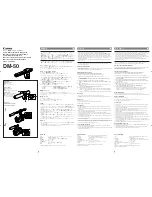
171.972UK, 171.973UK User Manual
In Use
Switching on the transmitter will open up the radio carrier frequency to the receiver and also send a
pilot tone frequency, which is not audible but is used by the receiver to open the audio channel. This
system helps to avoid any spurious radio frequencies interfering with the wireless microphone signal.
When the transmitter’s RF signal is recognized by the receiver, an RF meter will show the carrier
signal strength in the LCD display. Likewise, speaking into the microphone will send audio over this
carrier and an AF volume meter will show the audio level in the LCD display.
For the neckband or lavalier microphone, there is also a mute switch on the top of the bodypack,
which can be used to temporarily cut the microphone output whilst maintaining the carrier
frequency. This may be useful to silence the mic whilst moving across the front of speakers or as a
standby setting.
In addition, the bodypack has a Gain adjustment inside the battery compartment to match the gain
level for the type of neckband or lavalier microphone that is connected to it.
If the wireless system is to be out of use for longer than a few seconds, it is preferable to switch the
transmitter off, which deactivates the radio carrier signal and powers down the transmitter.
Be sure to turn down the volume of the mixer or amplifier and then switch off the receiver.
Unplug signal leads from the receiver and mixer or amplifier when moving or packing away.
If the system is not to be used for long periods of time, remove the batteries from the transmitters
and unplug the power adapter from the receiver and the mains outlet.
Folding away or removing the antennas can also help avoid damage when the system is not in use.























